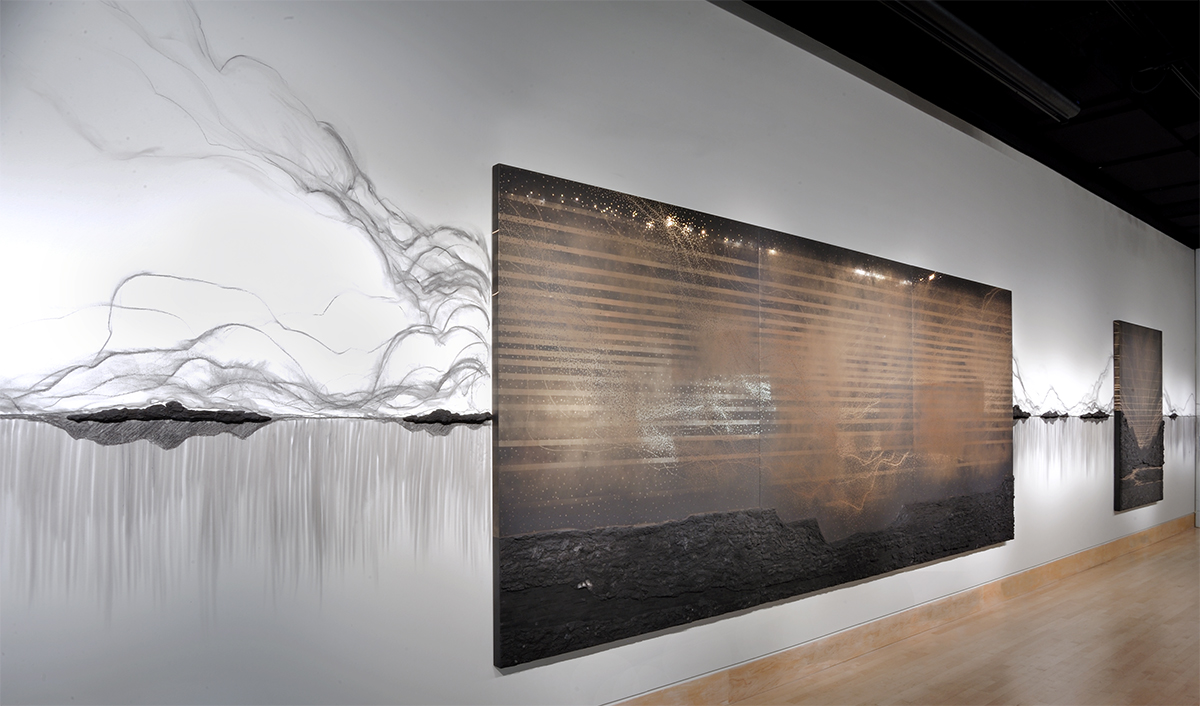Teresita Fernández: Dark Earth opens at Georgetown University’s de la Cruz Art Gallery
This semester the Maria & Alberto de la Cruz Art Gallery hosts its first exhibit, Teresita Fernández: Dark Earth, after being temporarily closed due to COVID-19. Critically acclaimed Fernández is known for luminous works that poetically evoke the landscape while exposing the violent colonial histories that inform our ideas of place.
“Landscape is more about what you don’t see than what you do see,” Fernández says.
About Dark Earth
In four panels from her series Dark Earth (2019), Fernández merges the conceptual and the material to challenge conventional ideas of the figure in the landscape in her first solo exhibition in Washington. Each panel presents a ghostly scene that reveals the cultural histories of their physical makeup—gold, conquest, violence, agriculture—and the fluctuation of power that surrounds natural resources.
Their golden, metallic surfaces prompt each viewer to linger, as their gaze is returned and distorted within the constructed landscape. With these works, Fernández prompts viewers to consider their own role in the eroded physical and psychological spaces produced by centuries of dominant colonialism.
The panoramic horizon of Charred Landscape (America), a site-specific installation, surrounds the Dark Earth panels–smoke rising from its peaks. Here, solid charcoal (made of burned trees) functions simultaneously as a sculptural element, drawing tool, ephemeral marks, and as a physical part of a real landscape. Both the imagery and materials reference the “slash and burn” technique traditionally used by Indigenous peoples to cultivate rotating crops and sustainably fertile terrain.
“After our long closure, we are excited to relaunch the de la Cruz Gallery with such an innovative and influential artist,” says Al Miner, founding director and chief curator of the Georgetown University Art Galleries. “With shimmering surfaces, mysterious imagery and intriguing textures, Fernández lures viewers into a critical conversation that crosses disciplines, geographies, and time periods. A liberal arts institution with a long-term commitment to social justice, Georgetown University is the perfect place to better acquaint diverse audiences with one of the most compelling artists working today.”
Teresita Fernández: Dark Earth is now open to the public, pre-registration is required to visit. Fernández and artist Cecilia Vicuña will launch a new panel discussion series on November 11th at 6pm, Be Seen AND Heard: Conversations with American Women Artists. This event will have limited capacity and require separate pre-registration, to sign up and for additional program details visit the Georgetown University Art Galleries’ website. The exhibition will remain on view through December 12th.
Also on View
Like the Fernández exhibition, a new show in the University’s Lucille M. and Richard F. X. Spagnuolo Gallery seeks to engage viewers in important and timely dialogue. Joseph Grigely: Songs, With And Without Words is guest curated by Yuri Stone, and is open now through December 12th.
Deaf since the age of 10, the Chicago-based Grigely is interested in the power of language, both spoken and written. The exhibition will feature eight digital prints from the series Songs Without Words (2008-) that communicate the energy and emotion of a vocalist or musician without sound. Additionally, on view in the Spagnuolo South Gallery through May 23, 2022 is Toni-Lee Sangastiano: Carnivalesque. Sideshows, freak shows, and circuses inspired these works in a variety of mediums by Georgetown Professor Sangastiano.
-by Shelby Roller (G’19)
- Tagged
- Art Galleries
- Exhibit
